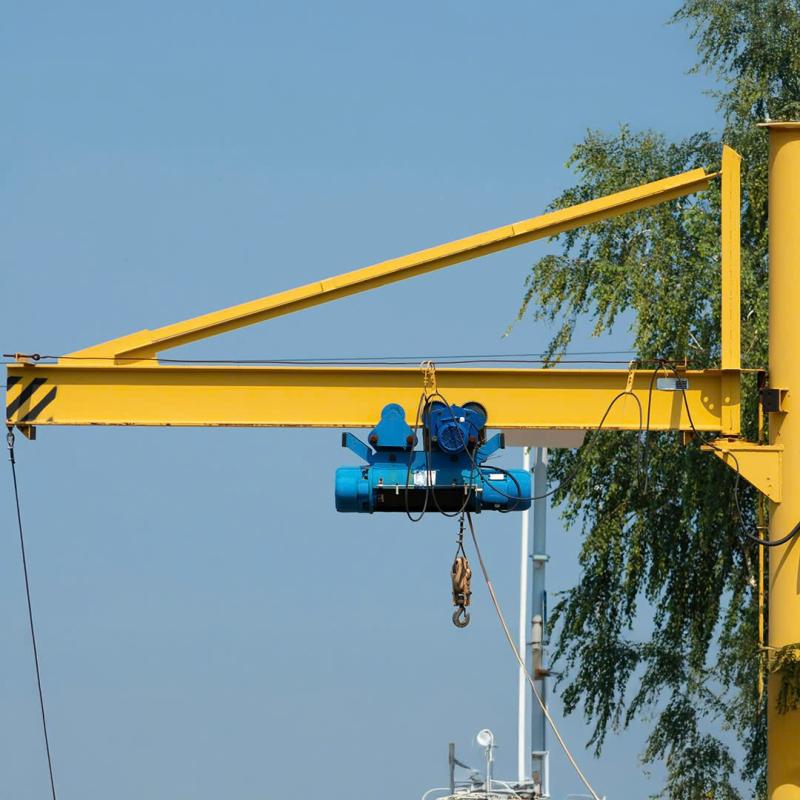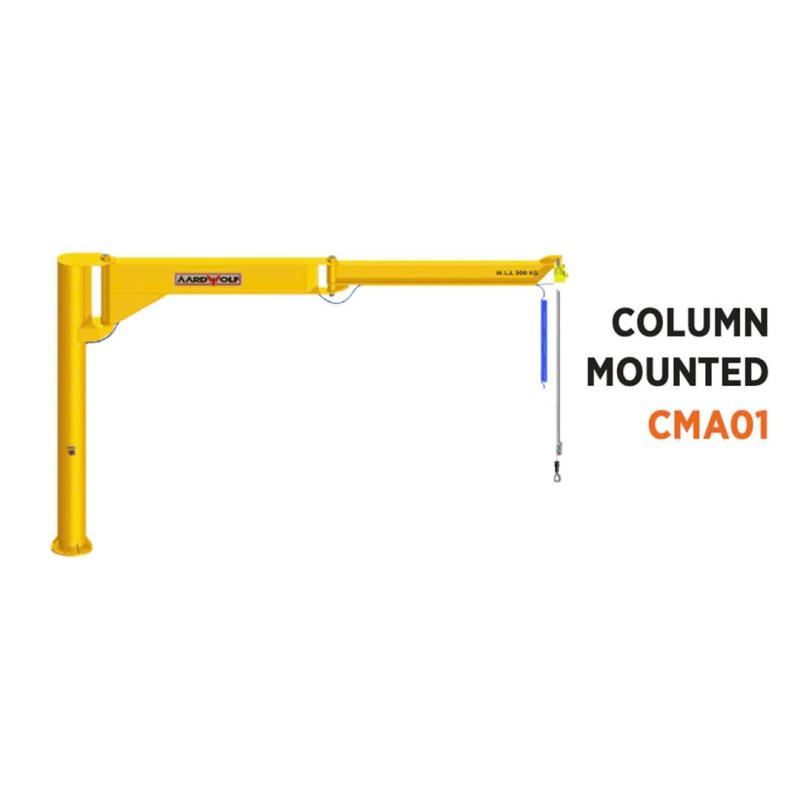



It supports the hoist and allows for the lifting and movement of loads in a circular or semi-circular area, often in industrial settings. Jib cranes are designed for repetitive, localized lifting tasks, making them useful in various applications like assembly lines, loading docks, and machine tending.
In this article, we’ll explore the definition of a jib, how it works within a crane system, and why jib cranes—including free standing jib cranes, wall mounted jib cranes, and articulating jib cranes—are ideal for space-saving, cost-effective lifting.
In a crane system, the jib (also known as a boom) is the horizontal arm that supports the hoist and trolley, allowing the crane to lift and move loads. It extends from a vertical support (mast or pillar) and enables the crane to move loads in a circular or semi-circular pattern. Essentially, the jib is the part of the crane that provides the reach and movement for lifting operations.
In the case of jib cranes, the jib is mounted either on a freestanding mast or attached to a wall or ceiling. The jib supports a hoist and trolley system that travels along its length, allowing precise positioning of materials within its radius of rotation.
A jib crane's key components include a vertical mast or support column, a horizontal jib (or boom) extending from the mast, a hoist for lifting, and a trolley that moves along the jib to provide horizontal movement. These components work together to allow for lifting and moving loads in a circular or semi-circular area.
This is the defining feature of the crane. The boom allows lateral movement of the hoist and is typically made from high-strength steel. Depending on the crane type, it may rotate 180°, 200°, or even a full 360°.
In freestanding jib cranes and pillar jib cranes, the vertical mast provides the structural support needed for heavy loads and full-range movement.
The hoist is the lifting mechanism mounted on the boom, which raises or lowers the load. It typically travels along the boom using a trolley, allowing horizontal movement.
Power cables are often managed using a festoon system, keeping them safe and organized. Cranes can be powered manually, pneumatically, or electrically.

Jib cranes are categorized by their mounting and jib configurations, offering diverse solutions for material handling needs. Common types include freestanding, wall-mounted, mast-type, and articulating jib cranes, each with unique advantages for specific applications.
Freestanding jib cranes, also known as cantilever or slewing arm cranes, are self-supporting lifting devices that are anchored to the floor and do not require support from building structures. They feature a horizontal boom, or jib, that can rotate, usually 360 degrees, and support a hoist for lifting and moving materials. These cranes are versatile, often used in individual work cells, open areas, and even outdoors, especially in areas where overhead cranes are not practical.
Best for: Facilities needing wide-range motion and heavy-duty lifting
Jib advantage: Full rotation with minimal structural dependence
A wall-mounted jib crane is a type of jib crane that is attached to a wall or structural column, rather than being mounted on a separate floor-standing support. This design is particularly useful for maximizing floor space and is often favored in environments with limited ground space, such as workshops and warehouses.
Best for: Space-constrained work areas
Jib advantage: Compact and efficient, with no need for additional foundation
Ceiling-mounted jib cranes are suspended from overhead beams or trusses, freeing up floor space and improving layout efficiency. They are often used in cleanrooms, assembly areas, or locations where the floor must remain unobstructed. These cranes consist of a horizontal arm (boom) that supports a hoist and trolley, which moves along the boom to provide lifting and positioning capabilities.
Best for: Assembly lines and congested facilities
Jib advantage: Zero footprint; efficient use of vertical space
An articulating jib crane, also known as an articulated jib arm, features two swivel arms joined by a pivot point, allowing for independent rotation and movement around corners and into hard-to-reach areas that traditional jib cranes can't access. This design provides greater flexibility and precision in material handling, especially in manufacturing and assembly settings.
Best for: Irregular or tight work zones
Jib advantage: Precise maneuverability around obstacles
Heavy-duty floor-mounted jib crane designed to provide reliable, long-life performance with minimal maintenance. This free-standing jib crane provides 360° rotation. The jib crane boom is fabricated out of a steel I-beam. A machined lower roller carriage is housed in the jib crane head section that features heavy steel side plates. The lower roller carriage is mounted on adjustable tension bolts to allow for field adjustments. The support column for the jib crane is constructed out of steel pipe with a heavy base plate and reinforcing gussets. The 360° Rotation - Pillar Mounted Jib Crane can be combined with a vacuum lifter and an electric hoist to meet your specific needs.
Best for: Permanent installations with existing steel support
Jib advantage: High capacity with minimal installation cost
Jib cranes are widely deployed across industries due to their versatility and reliability. Here are a few typical use cases where the jib plays a central role:
Warehousing: Lift and move pallets and equipment between shelves or assembly zones
Manufacturing: Precise part placement on production lines
Construction: Positioning tools and materials in hard-to-reach spaces
Shipping & Receiving: Loading and unloading from trucks and shipping containers

Jib cranes, incorporating a jib (an arm or boom extending from a support), offer numerous advantages in crane design, including increased reach and maneuverability, improved safety, enhanced precision and control, and cost-effectiveness, especially in confined spaces. They are particularly useful in manufacturing, construction, and other industries where localized lifting and precise material handling are crucial.
Wall and ceiling-mounted options save floor space while still providing excellent lifting range. The ability to fold away or stay out of the way during downtime makes them ideal for smaller facilities.
Compared to larger overhead or gantry cranes, jib cranes are more affordable to install and maintain, especially when used for repetitive, localized tasks.
Manufacturers like Spanco offer jib cranes with customizable jib lengths, rotation ranges, and mounting styles, allowing for seamless integration into new or existing workflows.
Spanco’s jib cranes meet OSHA, CMAA, ANSI, and MMA safety standards, ensuring that the jib component and its attachments are built to last and perform safely.

To choose the right jib crane, you must first define your specific lifting needs, considering load capacity, workspace dimensions, and the type of loads handled. Then, evaluate different jib crane types (freestanding, wall-mounted, mast-type, articulating) and their suitability for your application. Finally, assess factors like boom length, rotation, mounting options, and power requirements to ensure optimal performance and safety.
Load capacity
Boom length and rotation
Mounting method
Available space
Power source
Check out Exploring different types of jib cranes for detailed technical breakdowns, or use Aardwolf’s system selector to match a solution to your facility.
Conclusion: Why the Jib Is the Core of Any Jib Crane
The jib, or jib arm, is the core of any jib crane because it's the horizontal component that extends from the support structure (mast or wall) and carries the load-lifting mechanism (hoist and trolley). It's the part that enables the crane to reach out and move loads horizontally, making it essential for the crane's primary function of lifting and positioning materials.
By understanding what a jib is and how it functions across different crane types, you can make more informed decisions when investing in material handling equipment. If you’re ready to upgrade your lifting solution, explore how smart jib cranes provide straightforward lifting solutions tailored to your needs.
References
1. How to operate a Jib Crane safely
3. Over brace jib crane wall mounted
5. Is a Jib Crane a Gantry Crane
6. Articulated Jib Crane Wall Mounted
8. Manual Counterbalance Crane
10. Over Braced Jib Crane Column Mounted
Sign up to receive the latest info on new Aardwolf products, special offers and more.
By signing up you agree to receive emails from Aardwolf with news, special offers, promotions and other information. You can unsubscribe at any time.